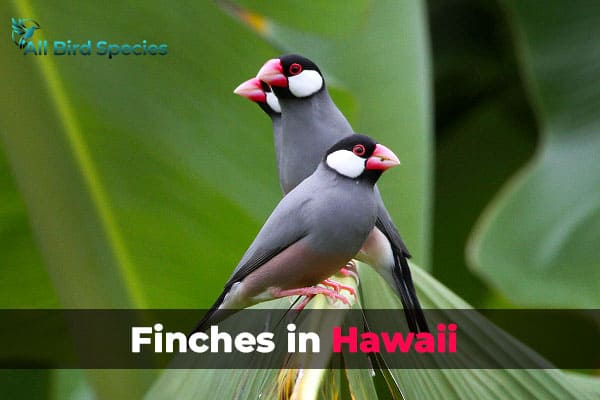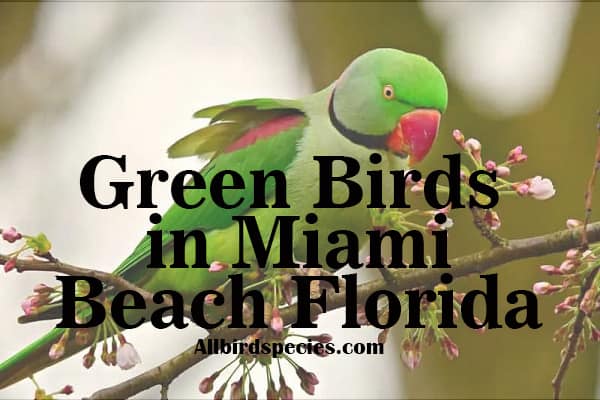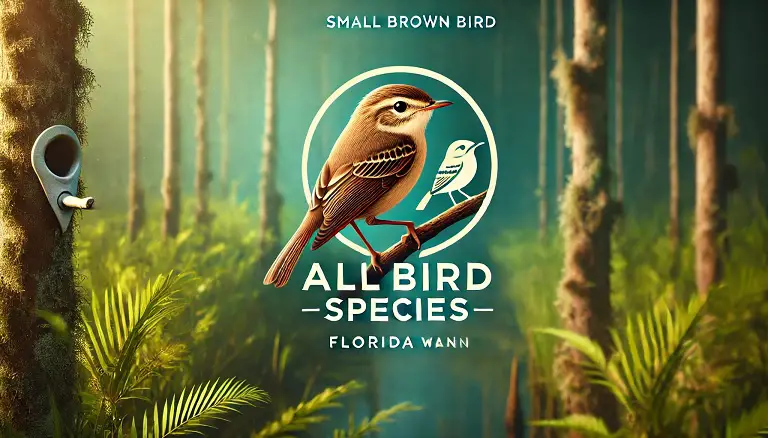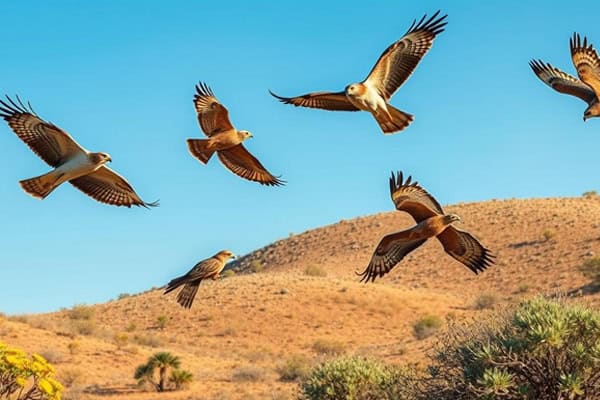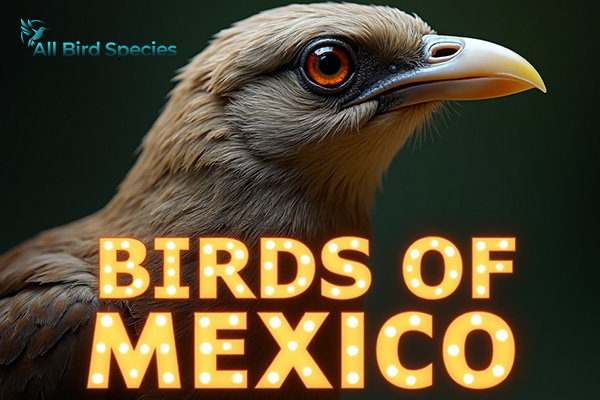Spotting 16 Types Of Finches In Hawaii (With Pictures)
Hawaii’s allure isn’t just its beaches; the Finches in Hawaii are a marvel, with 280 species making the islands their sanctuary. Many were introduced and thrive in urban areas, but it’s the native species that captivate. In my research, I’ve discovered these indigenous birds offer a unique glimpse into Hawaii’s ecosystem. They’re a must-see for any nature enthusiast visiting the islands.
One group of native birds is the Hawaiian finches, also called honeycreepers. Also, These little birds are part of the Fringillidae family. They mostly eat nectar or insects and live in the remote forests of Hawaii. Because they live in such isolated places and there aren’t many of them, we still have a lot to learn about their lives. Unfortunately, many of these colorful birds are in danger because of other animals that were brought to Hawaii.
Moreover, There are lots of great places in Hawaii to see birds and keep them safe. Also, Some of these spots include Wailoa River State Park, James Campbell National Wildlife Refuge, Kealia Pond National Wildlife Refuge, Pearl Harbour National Wildlife Refuge, and Kanaha Pond Wildlife Sanctuary. But there are also other places where you can find Hawaiian finches that aren’t as well known.
We’ll Learn About 16 Finches That You Can See In Hawaii
1. Akekee
- Scientific name – Loxops caeruleirostris
- Lifespan – Unknown
- Size (average) – 3.9 in (10 cm)
- Status – Critically endangered
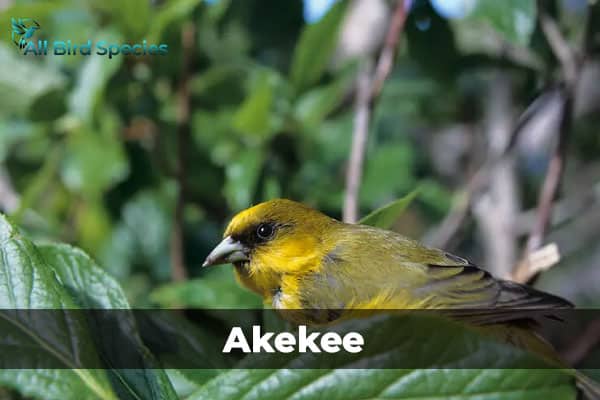
The male Akekee sports vibrant green on its upper parts, complemented by yellow underparts and a sunny yellow head topped with a small black mask. Females share a similar appearance but with a more muted palette. Both sexes boast a distinctive crossed, pale beak. When it comes to communication, they produce a sweet “suweet” call and serenade with a fluctuating trill.
These precious birds call the lofty heights of Ohia trees home, where they presumably raise multiple broods from March to July, each clutch typically containing one to three eggs. Their nests, small cup-shaped constructions of sticks, perch delicately on the branches of Ohia trees.
Diet-wise, the Akekee finches in hawaii is quite the opportunist, dining on larvae, spiders, and various insects.
Sadly, the Akekee’s numbers are plummeting at an alarming rate. With an estimated population of only about 1100 birds, it has declined by a staggering 98% since 2000. Its plight is worsened by invasive plants encroaching on its habitat, habitat degradation, diseases, competition with invasive insects, and predation.
It’s crucial that we rally together to protect and preserve these remarkable creatures before it’s too late.
2. Akiapolaau
- Scientific name – Hemignathus wilsoni
- Lifespan – 13 years (maximum recorded)
- Size (average) – 5.5 in (14 cm)
- Weight (average) – 1 oz (28.3 g)
- Wingspan – 7 to 7.8 in (18 to 20 cm)
- Status – Endangered

The male Akiapolaau bird has a back that’s greenish-yellow, with a yellow belly, and its head wears a black mask. The female, on the other hand, has an olive-colored back and a grayish-yellow belly. Both males and females have a unique beak, with a longer, curved upper part and a short, chisel-like lower part. When they chirp, they make a sound like “chuw-ee” or “teedle-oo.”
These birds, called Akiapolaau, mate all year round, but they mostly do so between February and July. They build their nests from sticks and place them in Ohia trees. Normally, they lay one or two eggs at a time.
Akiapolaau finches in hawaii mainly eat insects, larvae, and spiders, but they also enjoy sap.
Sadly, the Akiapolaau is in danger. There are only about 1900 of them left, and their numbers are dropping. They face threats like losing their homes because of construction, getting sick, invasive species, and other animals eating them
3. Akikiki
- Scientific name – Oreomystis bairdi
- Lifespan – Unknown
- Size (average) – 5.1 in (13 cm)
- Weight – 0.4 to 0.6 oz (12 to 17 g)
- Wingspan – Unknown
- Status – Critically endangered
Both male and female Akikiki birds have white bellies, grayish backs, and pink beaks. They sing a trilling song and make a quiet squeaking sound.

These birds, known as Akikiki, usually breed from March to June, and they build their nests in Ohia trees. Their nests are made from bark, moss, lichen, and plant fibers. Typically, they lay one or two eggs at a time.
The Akikiki mostly eats tiny creatures like insects and spiders.
Unfortunately, the Akikiki is in critical danger. There are fewer than 76 of them left, and their numbers are dropping fast. Their habitat is shrinking by 90%, and they face threats like diseases, losing their homes because of construction, natural disasters, competition with other birds and bugs, and other animals eating them
4. Akohekohe
- Scientific name – Palmeria dolei
- Lifespan – 9 years (maximum recorded)
- Size – 6.7 to 7 in (17 to 18 cm)
- Weight – Unknown
- Wingspan – Unknown
- Status – Critically endangered
Male and female Akohekohe birds wear black feathers adorned with white, grey, yellow, silver, or orange tips. They sport a striking orange eye-ring and an orange patch on the back of their neck. Their thighs range from orange to yellow-white, and they boast a large white crest on their heads. When they sing, they produce a mix of whistles, gurgles, and buzzes.
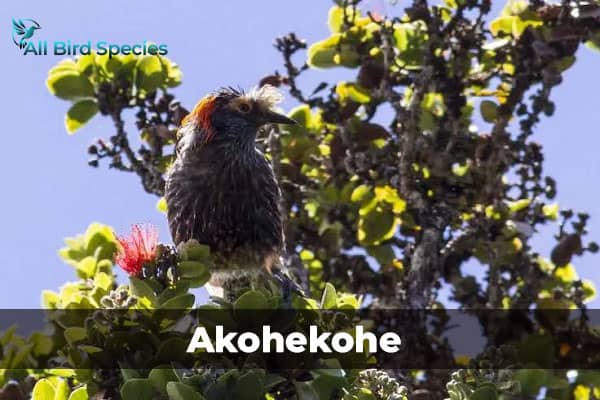
These birds, called Akohekohe, build cup-shaped nests, typically nestled in Ohia trees. They usually lay one or two eggs at a time.
Akohekohe birds mainly dine on nectar but also snack on some small arthropods.
Sadly, the Akohekohe is in critical danger. There are only about 2500 of them left, and their numbers are going down. They face threats like losing their homes because of construction, being eaten by other animals brought to Hawaii, and getting sick.
If you’re looking to spot an Akohekohe, head to Haleakala National Park on Maui. These rare birds live in forests filled with Ohia, Koa, Kawau, and Olapa trees, at altitudes ranging from 5,000 to 7,000 feet (1525 to 2133 meters)
5. Anianiau
- Scientific name – Magumma parva
- Lifespan – 9 years (maximum recorded)
- Size (average) – 3.9 in (10 cm)
- Weight – 0.32 to 0.35 oz (9 to 10 g)
- Wingspan – Unknown
- Status – Vulnerable

Meet the Anianiau bird – the males sport a sunny yellow hue, while the females lean towards a softer yellowish-green. Their song is a cheerful trill that goes like “weesee-weesee-wee-see”, while their call is a sweet “su-weet”.
Come breeding season, which spans from February to June, these birds construct cozy cup-shaped nests. Each clutch typically contains up to three eggs.
When it’s mealtime, the Anianiau dines on a menu of insects, spiders, nectar, and fruit.
While they’re classified as vulnerable, there’s some good news: their population trend is holding steady. Currently, there are around 8,700 of these birds in existence, but their habitat has shrunk by a substantial 85% from its historical range. Threats like diseases, habitat loss, competition from introduced species, and predation loom over their future.
6. Apapane
- Scientific name – Himatione sanguinea
- Lifespan – 11 years (maximum recorded)
- Size (average) – 5.1 in (13 cm)
- Weight – 0.5 to 0.56 oz (14.4 to 16 g)
- Wingspan – Unknown
- Status – Least concern
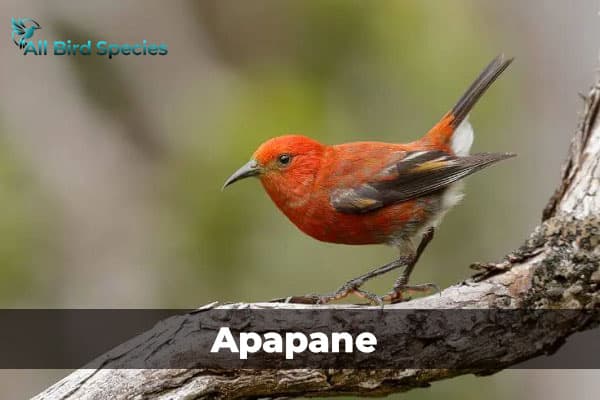
Both male and female Apapane birds are a vibrant crimson color all over, with black wings, a black upper tail, black legs, and a white patch on their rump. Their song sounds like “dee-der-di-di-di.”
These birds, known as Apapane, build their nests in Ohia trees, crafting cup-shaped homes from moss, twigs, lichen, bark, leaves, and roots. They typically lay up to three eggs at a time and usually breed between January and March.
These finches of hawaii mostly sip nectar for their meals.
Thankfully, the Apapane is not currently in danger, with a stable population of around 1,300,000 individuals. However, they still face threats like losing their homes because of construction, being eaten by other animals, getting sick, and competing with other birds for food and space
7. Hawaii Akepa
- Scientific name – Loxops coccineus
- Lifespan – 10 years (maximum recorded)
- Size – 3.9 to 5.1 in (10 to 13 cm)
- Weight – 0.3 to 0.4 oz (10 to 12 g)
- Wingspan – 2.3 to 2.7 in (6 to 7 cm)
- Status – Endangered
Let’s talk about the Hawaii Akepa bird. The guys rock a vibrant orange look, while the gals go for a more subdued greenish-grey, jazzed up with a yellow band across their chests. Both sport a pale beak with a cute cross.

When it comes to music, they’re quite the singers, belting out a trilly tune and a soft “tiddle-ee” call.
For nesting, they cozy up in tree hollows of Ohia and Koa trees, with breeding season running from March to June. Each clutch usually holds one or two eggs.
Their diet? Mostly insects.
Sadly, these birds are in trouble. Once found on Oahu and Maui, they’re now limited to Hawaii Island. With only about 14,000 individuals left, their numbers are dropping. Threats like habitat loss, diseases, and predators are putting the squeeze on their survival.
8. Hawaii Amakihi
- Scientific name – Chlorodrepanis virens
- Lifespan – 12 years (maximum recorded)
- Size (average) – 4.3 in (11 cm)
- Weight – 0.3 to 0.6 oz (10 to 16 g)
- Wingspan – Unknown
- Status – Least concern
The male Hawaii Amakihi bird sports a yellow-green or olive-colored body, with a black curved beak, a light-colored face, black spots near its eyes, and lighter-colored belly feathers. The female looks similar to the male but with less bright feathers. Also, This bird sings a trilling song and makes a “chee” sound.

Besides this, These birds also, called Hawaii Amakihi, create cup-shaped nests using twigs, grass, and leaves. The female usually lays two to three eggs at a time, and they mate all year round.
Hawaii Amakihi birds munch on insects, nectar, and fruit for their meals.
The Hawaii Amakihi isn’t considered to be in danger right now because it’s adaptable and can handle changes in its environment better than some other native Hawaiian finches which is really impressive. However, it’s no longer found on Lanai. We’re not sure exactly how many there are, but their population seems steady. Still, they could face problems like losing their homes because of construction, getting sick, or other animals eating them
9. Hawaii Creeper
- Scientific name – Loxops mana
- Lifespan – Unknown
- Size – 4.3 to 5.1 in (11 to 13 cm)
- Weight – 0.4 to 0.5 oz (13 to 15 g)
- Wingspan – Unknown
- Status – Endangered
Both male and female Hawaii Creeper birds have olive-green backs, light-colored bellies, and a dark grey mask on their faces. Males tend to be a bit more colorful than females. These birds sing a trilling song and make a squeaking “squeet” sound.

The Hawaii Creeper builds its nest in open cup shapes, usually in holes or gaps in tree bark. Females typically lay two eggs at a time.
For meals, Hawaii Creeper birds prefer insects, spiders, and other small creatures without backbones.
Unfortunately, the Hawaii Creeper is endangered. There are only about 12,000 of them left, and their numbers are dropping. They used to live at lower altitudes but now only stay in higher places. They face dangers like being eaten by other animals, getting sick, competing with other birds, losing their homes because of construction, and having their habitats broken up
10. ‘I’iwi
- Scientific name – Drepanis coccinea
- Lifespan – Unknown
- Size (average) – 5.5 in (14 cm)
- Weight – 0.7 to 1 oz (16 to 19 g)
- Wingspan – Unknown
- Status – Vulnerable
Let’s talk about the I’iwi bird – both guys and gals rock a scarlet outfit with a sleek black tail and wings. Their standout feature? A long, curvy peach-colored beak that’s hard to miss. When they’re feeling chatty, they let out a mix of chuckles and gurgles.
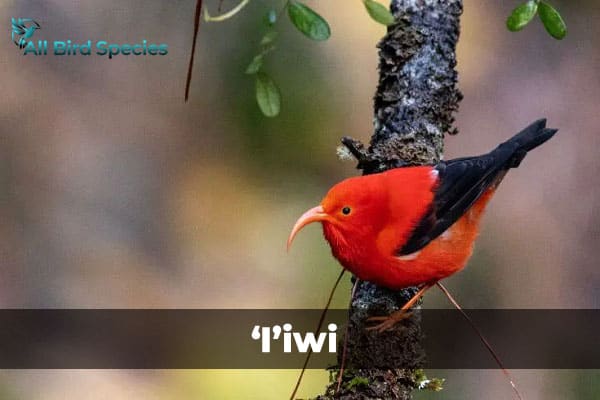
For nesting, they cozy up in Ohia trees, fashioning snug cup-shaped nests. Mama bird usually lays about two eggs per batch.
When it’s time to eat, these birds have a sweet tooth for nectar, although they’ll snack on arthropods too.
In terms of numbers, they’re classified as vulnerable, but there’s a silver lining – there are about 605,000 of them out there, holding steady. Interestingly, they’ve taken a liking to nectar from non-native plants, which might explain their decent population size. But it’s not all smooth sailing – threats like habitat loss, predators, invasive species, and diseases are still looming over their heads.
11. Kauai Amakihi
- Scientific name – Chlorodrepanis stejnegeri
- Lifespan – 9 years (maximum recorded)
- Size (average) – 4.3 in (11 cm)
- Weight (average) – 0.6 oz (17 g)
- Wingspan – Unknown
- Status – Vulnerable
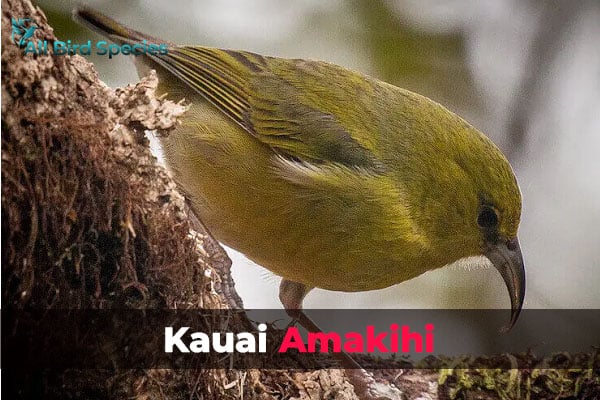
The male Kauai Amakihi bird shines bright yellow with a green back, green wings, black spots near its eyes, and a curved beak. The female isn’t as colorful as the male. This bird makes a “chee” sound and sings a trilling song.
Kauai Amakihi birds build their nests in Ohia trees. The female usually lays up to three eggs at a time.
When it comes to food, Kauai Amakihi birds enjoy nectar, fruit, and insects.
Although the Kauai Amakihi is considered vulnerable, there are about 7,000 of them, and their population is growing. However, they still face dangers like getting sick, losing their homes because of construction, and other animals eating them
12. Laysan Finch
- Scientific name – Telespiza cantans
- Lifespan – 12 years (maximum recorded)
- Size – 5.9 to 6.7 in (15 to 17 cm)
- Weight – 1.1 to 1.2 oz (32 to 34 g)
- Wingspan – Unknown
- Status – Vulnerable
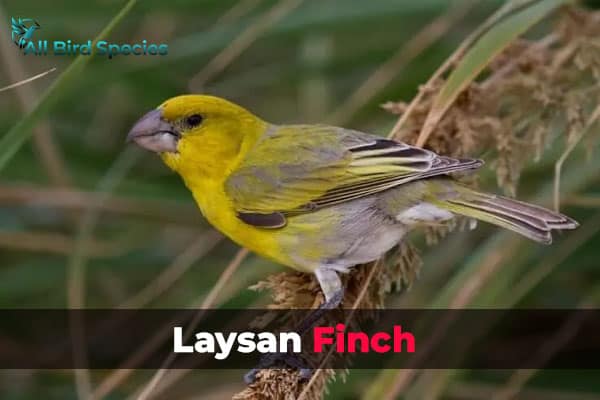
The Laysan Finch boasts a sizable pale beak, seen in both males and females. Males sport a bright yellow head and breast, while females are paler with streaking on the back. They sing a variety of tunes.
Nesting in grass bunches, females lay two to four eggs.
Their diet includes seeds, flowers, fruits, insects, and more.
This vulnerable finches species in hawaii has an estimated population of 15,600 individuals, facing threats from invasive plants and introduced mammals.
You can spot Laysan Finches on Laysan Island and the Pearl and Hermes Atoll, where they’ve been translocated. They inhabit grasses, herbs, and vines on these islands.
13. Maui Parrotbil
- Scientific name – Pseudonestor xanthophrys
- Lifespan – 16 years (maximum recorded)
- Size (average) – 5.5 in (14 cm)
- Weight – 0.7 to 0.9 oz (20 to 25 g)
- Wingspan – Unknown
- Status – Critically endangered
The male Maui Parrotbill bird wears olive-green feathers on its back, with yellow feathers underneath, and it’s known for a special yellow stripe near its eye. The female isn’t as bright as the male, and her beak is a bit smaller. Both males and females have big, parrot-like beaks. This bird sings a “chewy-chewy-chewy” song and makes a “chu-wee” sound.
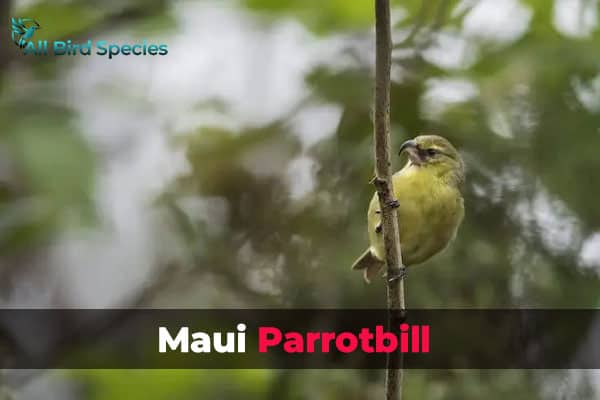
Maui Parrotbill birds build cup-shaped nests using lichen and twigs. The female only lays one egg each breeding season.
When it’s mealtime, Maui Parrotbill birds munch on insects and their larvae.
Unfortunately, the Maui Parrotbill is in critical danger. There are fewer than 200 of them left, and their numbers are going down. They face threats like losing their homes because of construction, being eaten by other animals, getting sick, and not having enough babies
14. Nihoa Finch
- Scientific name – Telespiza ultima
- Lifespan – 11 years (maximum recorded)
- Size (average) – 6.7 in (17 cm)
- Weight – 0.7 to 1 oz (21 to 28 g)
- Wingspan – Unknown
- Status – Critically endangered
The male Nihoa Finch stands out with its yellow breast and head, grey belly, and dark greyish-yellow back. Females are a paler yellow color with streaks on their backs and sides. Both males and females have hefty bills. This bird sings a loud and melodious tune.
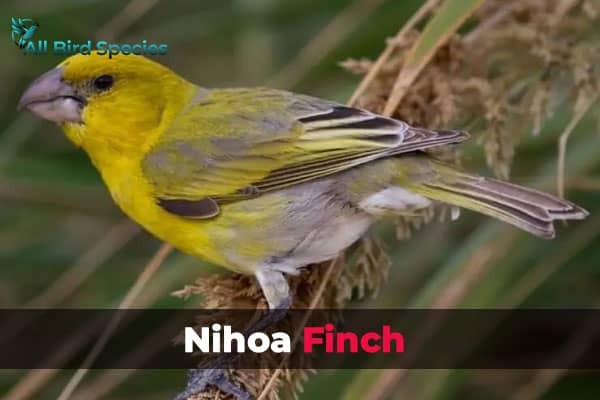
Nihoa Finch birds make their nests in rock crevices, where the female typically lays two to five eggs at a time.
When it’s time to eat, Nihoa Finch birds have quite the varied diet, including seeds, fruit, leaves, flowers, stems, roots, eggs, carrion, insects, and spiders.
Even though the Nihoa Finch is critically endangered, there are around 2,800 of them left, and their numbers seem steady. They face threats like invasive plants, sudden increases in insect populations, and other animals introduced to their habitat.
If you’re looking to spot a Nihoa Finches in hawaii, head to Nihoa Island. These birds are pretty common across the island, especially in rocky and shrubby areas and open spaces with vegetation. You might also find them near water sources like seeps and puddles.
15. Oahu Amakihi
- Scientific name – Chlorodrepanis flava
- Lifespan – Unknown
- Size (average) – 4.5 in (11.4 cm)
- Weight (average) – 0.45 oz (13 g)
- Wingspan – 5.9 to 6.9 in (15 to 17.5 cm)
- Status – Vulnerable
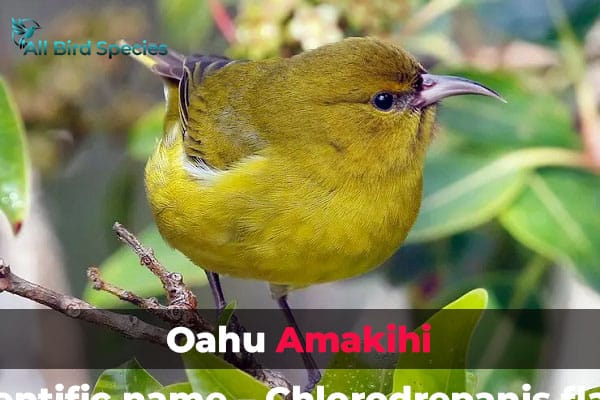
Male Oahu Amakihi birds shine with bright yellow feathers and black spots near their eyes, while females are less colorful and feature two white stripes on their wings. Both males and females have curved beaks. This bird’s song is a trill, and it makes a “chee” call.
Not much is known about how Oahu Amakihi birds build their nests, but it’s believed to be similar to Hawaii Amakihi.
When it’s time to eat, Oahu Amakihi birds enjoy insects, fruit, and nectar.
Although the Oahu Amakihi is vulnerable, there could be around 60,000 of them, and their numbers seem steady. They’ve even started living in suburban areas in recent years. However, they still face threats like being eaten by other animals, losing their homes because of construction, getting sick, and fires.
16. Palila
- Scientific name – Loxioides bailleui
- Lifespan – 13 years (maximum recorded)
- Size – 5.9 to 7.5 in (15 to 19 cm)
- Weight – 1.3 to 1.4 oz (37 to 40 g)
- Wingspan – Unknown
- Status – Critically endangered
The male Palila bird boasts a vibrant yellow head and chest, a grey back, a whitish belly, green wings, and a green tail. These finches in hawaii face wears a dark mask, and it sports a large, dark beak. Females have more muted colors. This bird tends to be quiet but sometimes makes a “pah-lee-lah” call.
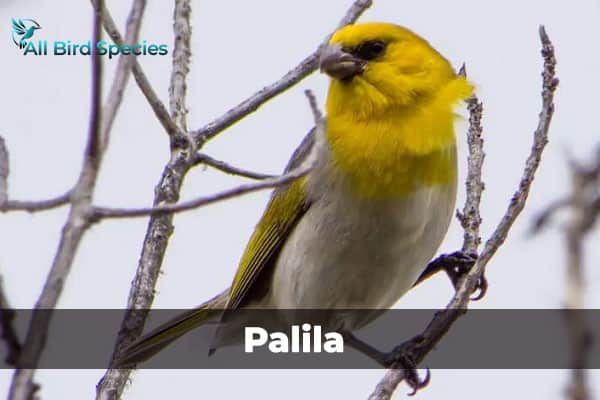
Palila birds build their nests in Mamane trees, with the female usually laying two eggs at a time.
For meals, Palila birds primarily dine on green Mamane tree seed pods. They also eat Mamane leaves, buds, and flowers, as well as Naio berries.
Sadly, the Palila is critically endangered, with only about 1,900 individuals left, and their numbers are decreasing. They’ve lost 90% of their historic territory. They face threats like fires, invasive plants, wild animals, diseases, and other animals eating them.
If you’re looking to spot a Palila, head to the dry forests on the western slope of Mauna Kea volcano on Hawaii Island, where they’re native. These birds can be found in Mamane forests or mixed Mamane and Naio forests at elevations between 6,500 and 9,250 feet (2,000 and 2,850 meters). You might spot them along the Palila Discovery Trail.
Check Our Previous Article
Frequently Asked Questions About Finches in Hawaii
Q1: Does Hawaiʻi have finches?
Yes, Hawaiʻi does have finches.
Q2: How did the finch get to Hawaii?
Finches likely arrived in Hawaii through natural means like wind currents or via human introduction.
Q3: What are the yellow finches in Hawaii?
The yellow finches in Hawaiʻi are likely referring to the Hawaiian honeycreeper birds, such as the ʻIʻiwi or the ʻAmakihi, which have yellow plumage.
Q4: What kind of birds do they have in Hawaii?
Hawaiʻi boasts a diverse range of birds including native species like the Hawaiian honeycreepers, seabirds, and introduced species like the common myna and red-vented bulbul.

